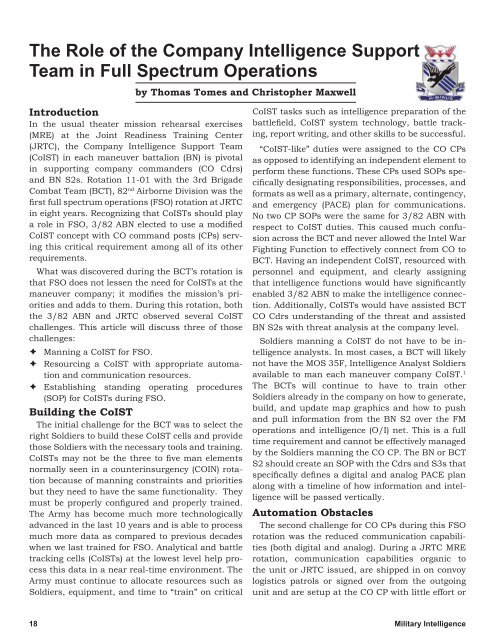George w. casey jr. - Federation of American Scientists
George w. casey jr. - Federation of American Scientists
George w. casey jr. - Federation of American Scientists
You also want an ePaper? Increase the reach of your titles
YUMPU automatically turns print PDFs into web optimized ePapers that Google loves.
The Role <strong>of</strong> the Company Intelligence Support<br />
Team in Full Spectrum Operations<br />
by Thomas Tomes and Christopher Maxwell<br />
Introduction<br />
In the usual theater mission rehearsal exercises<br />
(MRE) at the Joint Readiness Training Center<br />
(JRTC), the Company Intelligence Support Team<br />
(CoIST) in each maneuver battalion (BN) is pivotal<br />
in supporting company commanders (CO Cdrs)<br />
and BN S2s. Rotation 11-01 with the 3rd Brigade<br />
Combat Team (BCT), 82 nd Airborne Division was the<br />
first full spectrum operations (FSO) rotation at JRTC<br />
in eight years. Recognizing that CoISTs should play<br />
a role in FSO, 3/82 ABN elected to use a modified<br />
CoIST concept with CO command posts (CPs) serving<br />
this critical requirement among all <strong>of</strong> its other<br />
requirements.<br />
What was discovered during the BCT’s rotation is<br />
that FSO does not lessen the need for CoISTs at the<br />
maneuver company; it modifies the mission’s priorities<br />
and adds to them. During this rotation, both<br />
the 3/82 ABN and JRTC observed several CoIST<br />
challenges. This article will discuss three <strong>of</strong> those<br />
challenges:<br />
Manning a CoIST for FSO.<br />
Resourcing a CoIST with appropriate automation<br />
and communication resources.<br />
Establishing standing operating procedures<br />
(SOP) for CoISTs during FSO.<br />
Building the CoIST<br />
The initial challenge for the BCT was to select the<br />
right Soldiers to build these CoIST cells and provide<br />
those Soldiers with the necessary tools and training.<br />
CoISTs may not be the three to five man elements<br />
normally seen in a counterinsurgency (COIN) rotation<br />
because <strong>of</strong> manning constraints and priorities<br />
but they need to have the same functionality. They<br />
must be properly configured and properly trained.<br />
The Army has become much more technologically<br />
advanced in the last 10 years and is able to process<br />
much more data as compared to previous decades<br />
when we last trained for FSO. Analytical and battle<br />
tracking cells (CoISTs) at the lowest level help process<br />
this data in a near real-time environment. The<br />
Army must continue to allocate resources such as<br />
Soldiers, equipment, and time to “train” on critical<br />
CoIST tasks such as intelligence preparation <strong>of</strong> the<br />
battlefield, CoIST system technology, battle tracking,<br />
report writing, and other skills to be successful.<br />
“CoIST-like” duties were assigned to the CO CPs<br />
as opposed to identifying an independent element to<br />
perform these functions. These CPs used SOPs specifically<br />
designating responsibilities, processes, and<br />
formats as well as a primary, alternate, contingency,<br />
and emergency (PACE) plan for communications.<br />
No two CP SOPs were the same for 3/82 ABN with<br />
respect to CoIST duties. This caused much confusion<br />
across the BCT and never allowed the Intel War<br />
Fighting Function to effectively connect from CO to<br />
BCT. Having an independent CoIST, resourced with<br />
personnel and equipment, and clearly assigning<br />
that intelligence functions would have significantly<br />
enabled 3/82 ABN to make the intelligence connection.<br />
Additionally, CoISTs would have assisted BCT<br />
CO Cdrs understanding <strong>of</strong> the threat and assisted<br />
BN S2s with threat analysis at the company level.<br />
Soldiers manning a CoIST do not have to be intelligence<br />
analysts. In most cases, a BCT will likely<br />
not have the MOS 35F, Intelligence Analyst Soldiers<br />
available to man each maneuver company CoIST. 1<br />
The BCTs will continue to have to train other<br />
Soldiers already in the company on how to generate,<br />
build, and update map graphics and how to push<br />
and pull information from the BN S2 over the FM<br />
operations and intelligence (O/I) net. This is a full<br />
time requirement and cannot be effectively managed<br />
by the Soldiers manning the CO CP. The BN or BCT<br />
S2 should create an SOP with the Cdrs and S3s that<br />
specifically defines a digital and analog PACE plan<br />
along with a timeline <strong>of</strong> how information and intelligence<br />
will be passed vertically.<br />
Automation Obstacles<br />
The second challenge for CO CPs during this FSO<br />
rotation was the reduced communication capabilities<br />
(both digital and analog). During a JRTC MRE<br />
rotation, communication capabilities organic to<br />
the unit or JRTC issued, are shipped in on convoy<br />
logistics patrols or signed over from the outgoing<br />
unit and are setup at the CO CP with little effort or<br />
18 Military Intelligence















